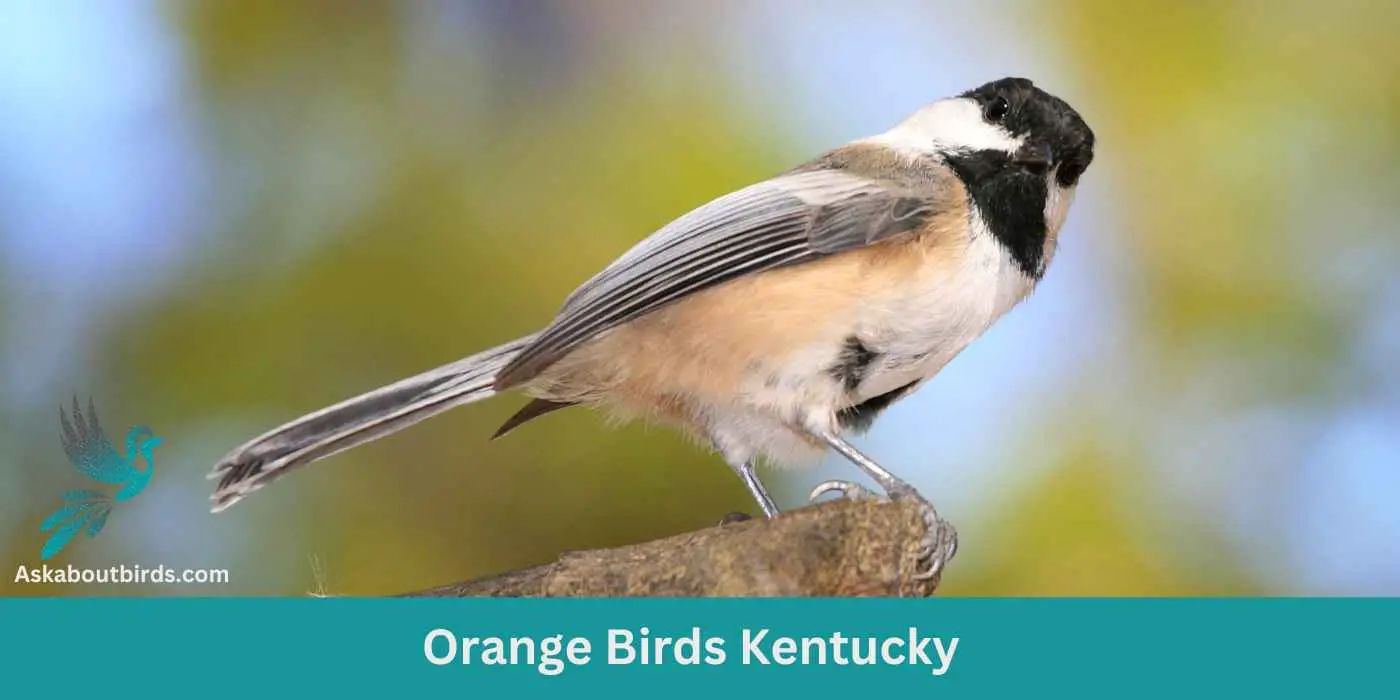Nestled amidst the rolling hills and dense woodlands, Kentucky is a birdwatcher’s delight, teeming with vibrant avian wonders. Among its feathered inhabitants are striking orange-hued birds, each more captivating than the last. From the fiery brilliance of the Baltimore Oriole to the subtle rust of the American Robin, Kentucky’s skies and trees are dotted with these colorful gems.
Dive into the heart of Kentucky’s avian beauty with our guide on 9 radiant orange birds. Explore each one’s distinct charm and grab your free photo guide to make your birdwatching in the Bluegrass State even more memorable!
Orange Birds Found In Kentucky
Kentucky’s diverse landscapes of rolling hills, dense forests, and meandering rivers create a rich tapestry that attracts a wide variety of bird species.
Baltimore Oriole


| Feature | Measurement |
|---|---|
| Scientific Name | Icterus galbula |
| Length | 6.7–8.7 in |
| Wingspan | 9.1–12.6 in |
| Weight | 22.3-42 g |
The Baltimore Oriole is a stunning bird, best known for its vibrant coloration and its rich, whistling song.
Appearance: The male Baltimore Oriole is notable for his bright orange and black plumage and black and white wing bars, a stark contrast to the more muted yellow-brown coloration of the female. Both sexes, however, have long pointed bills and white bars on their wings.
Diet: Baltimore Orioles have a diverse diet that includes insects, fruits, and nectar. Their preference for sweet juices and fruit pulp often brings them to backyard feeders offering oranges and jelly.
Reproduction: The female Baltimore Oriole is responsible for building the distinctive hanging nest, often woven together from fine materials like hair and grass. These nests are usually high in trees to avoid predators. The female lays 3-7 eggs, which are incubated for about two weeks.
Orchard Oriole
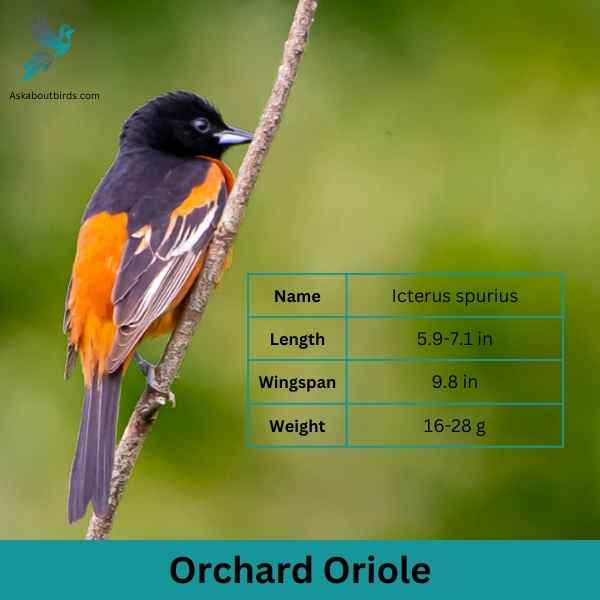
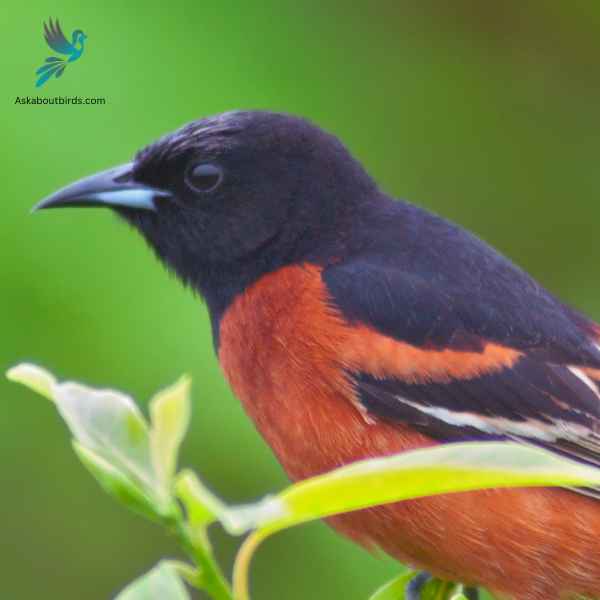
| Feature | Measurement |
|---|---|
| Scientific Name | Icterus spurius |
| Length | 5.9-7.1 in |
| Wingspan | 9.8 in |
| Weight | 16-28 g |
The Orchard Oriole is a small songbird noted for its distinctive coloration and melodic song.
Appearance: Male Orchard Orioles are a striking sight with their dark chestnut body and black head and black and white wings, while females and immature males are olive-green and feature a yellowish underpart. The species is often recognized by its slender body and pointed bill.
Diet: The diet of the Orchard Oriole consists primarily of insects, fruits, and nectar. They are adept at catching insects mid-air and are also known to sip nectar from flowers, aiding in pollination. When fruits are in season, they make up a substantial portion of the bird’s diet.
Reproduction: Orchard Orioles often nest in open woodlands and orchards, hence their name. The female is responsible for building the nest, typically choosing a location in a tree or shrub. The female lays a clutch of 4 to 6 eggs, which she incubates for about two weeks.
Scarlet Tanager


| Feature | Measurement |
|---|---|
| Scientific Name | Piranga olivacea |
| Length | 6.3 to 7.5 in |
| Wingspan | 9.8 to 11.8 in |
| Weight | 23.5 to 38 g |
The Scarlet Tanager is a strikingly colorful bird known for its brilliant plumage and distinctive song.
Appearance: Male Scarlet Tanagers are notable for their vibrant scarlet bodies contrasted with black wings and tail, making them one of the most intensely colored birds. Females and juveniles, on the other hand, have a subdued olive-yellow body color with darker wings and tail.
Diet: The diet of the Scarlet Tanager is largely made up of insects, including beetles, cicadas, aphids, and others. They are adept flycatchers, seizing insects in mid-air or picking them off foliage. They also consume fruits and berries, especially during migration and in their winter habitats.
Reproduction: The female Scarlet Tanager builds a cup-shaped nest using twigs, rootlets, and grass, typically well-hidden in the dense foliage of trees. She lays 3 to 5 eggs and incubates them for about two weeks.
American Redstart


| Feature | Measurement |
|---|---|
| Scientific Name | Setophaga ruticilla |
| Length | 4.3 to 5.5 in |
| Wingspan | 6.3 to 9.1 in |
| Weight | 8.6 g |
The American Redstart is a lively warbler known for its vivid colors and active hunting style, often seen flitting about, fanning its tail to startle and catch insects.
Appearance: Adult male American Redstarts boast striking black plumage with bright orange patches on the sides, wings, and tail. Females and immature males have grayish-olive upperparts with yellow patches in the same areas where the males display orange.
Diet: American Redstarts are primarily insectivores. They actively forage for flying insects, as well as caterpillars and spiders, often using their colorful tails to startle prey and make them easier to catch.
Reproduction: The female American Redstart builds a cup-shaped nest in the fork of a tree branch. Typically, she lays a clutch of 3 to 5 eggs. The female takes on the primary responsibility of incubating the eggs, while both parents participate in feeding the fledglings after they hatch.
Eastern Towhee

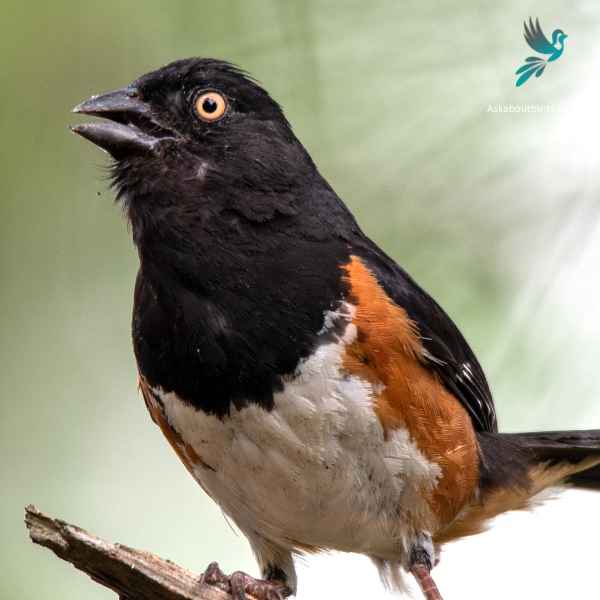
| Feature | Measurement |
|---|---|
| Scientific Name | Pipilo erythrophthalmus |
| Length | 6.8 to 9.1 in |
| Wingspan | 7.9–11.8 in |
| Weight | 32 to 53 g |
The Eastern Towhee is a distinctive songbird known for its unique calls and eye-catching coloration.
Appearance: Male Eastern Towhees are characterized by a striking combination of a black head, back and tail, contrasting with a white belly and rufous flanks. Females sport similar patterns but instead of black, they have a rich brown color. Both genders have red eyes, lending a special charm to their overall appearance.
Diet: Eastern Towhees primarily feed on a variety of insects, seeds, and berries. Their diet is quite diverse, taking advantage of seasonal offerings, which includes beetles, caterpillars, spiders, acorns, grass seeds, and various fruits and berries.
Reproduction: Eastern Towhees build their nests on or near the ground, often in a shrub or a small tree. The female lays around 3-5 eggs and takes the primary role in incubating them over about 12-13 days.
Red Crossbill

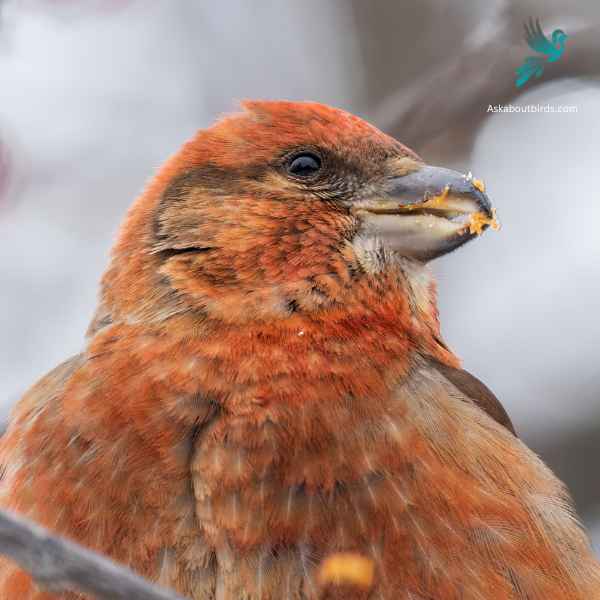
| Feature | Measurement |
|---|---|
| Scientific Name | Loxia curvirostra |
| Length | 5.5–7.5 in |
| Wingspan | 9.8–10.6 in |
| Weight | 0.9–1.4 oz |
The Red Crossbill is a distinctive finch known for its unusual bill, which has evolved to extract seeds from conifer cones.
Appearance: Males are typically bright red or orange, while females are greenish-yellow or olive. Both genders have the characteristic crossed bill, which they use to expertly extract seeds from tightly closed conifer cones.
Diet: Red Crossbills primarily feed on the seeds of coniferous trees, such as spruce, pine, and fir. Their specialized bills allow them to efficiently pry apart conifer cone scales to access the seeds.
Reproduction: Red Crossbills are somewhat nomadic and don’t adhere to a strict breeding schedule. Instead, they breed whenever and wherever food is abundant. Their nests are usually built on horizontal branches of conifer trees.
American Robins


| Feature | Measurement |
|---|---|
| Scientific Name | Leptotila plumbeicep |
| Length | 10.6-11.8 in |
| Wingspan | — |
| Weight | 160-200 g |
The American Robin is a widely recognized bird species known for its melodious song and early bird tendencies.
Appearance: American Robins are medium-sized birds with a distinctive appearance. Both males and females sport a gray to brown back and a warm red to orange breast and belly and gray wings. They also have a characteristic white eye-ring and a black head, but males are usually darker than females.
Diet: American Robins have a diverse diet that changes depending on the season. In summer, they feed heavily on earthworms, beetles, and other invertebrates, which they catch on the ground. During winter, they mostly eat fruits and berries.
Reproduction: American Robins usually build their nests in trees or shrubs, but they are also known to nest on human-made structures. The female lays a clutch of about 3 to 5 eggs, which she incubates for about 12 to 14 days.
Summer Tanager


| Feature | Measurement |
|---|---|
| Scientific Name | Piranga rubra |
| Length | 6.7 in |
| Wingspan | 28 to 30 cm |
| Weight | 29 g |
The Summer Tanager is a medium-sized songbird admired for its radiant plumage and melodious song.
Appearance: Male Summer Tanagers are an impressive bright red, while females and juveniles present a softer, yellow-orange color. Both genders have a large, slightly hooked bill and relatively short tail.
Diet: Summer Tanagers primarily feed on insects, including bees and wasps, which they catch in flight or pick off vegetation. They are also known to eat fruits and berries, making them helpful in controlling pest populations and seed dispersal.
Reproduction: The female Summer Tanager builds a loose, shallow cup-shaped nest out of twigs and grass, usually hidden in the foliage of trees. The female typically lays 3-5 eggs, which she will incubate for about two weeks.
Where to Spot Kentucky’s Orange Birds
Kentucky’s lush terrains are a haven for bird enthusiasts, especially those keen on spotting vibrant orange-feathered species. Here are some of the top birding spots in the Bluegrass State where you’re likely to encounter a burst of orange among the green:
- Mammoth Cave National Park: With over 400 miles of explored caves and dense woodlands, this park offers a diverse habitat for many bird species, including the brilliant Baltimore Oriole and the elusive Scarlet Tanager.
- Bernheim Arboretum and Research Forest: An expansive area with varied habitats from forests to meadows, Bernheim is especially known for its migratory bird populations and offers a good chance to spot the Orchard Oriole during certain seasons.
- Lake Barkley and Kentucky Lake: These large freshwater reservoirs and their surrounding areas are magnets for a wide variety of birds. The lakeshores and nearby woodlands are particularly good for spotting the Red-headed Woodpecker and Eastern Towhee.
- Red River Gorge Geological Area: Nestled in the Daniel Boone National Forest, this area with its unique rock formations and rich forests is a hotspot for Summer Tanagers and American Redstarts.
- Land Between the Lakes National Recreation Area: Spanning across Kentucky and Tennessee, this area boasts a mix of woodlands and wetlands, providing ample opportunities for birdwatchers to spot both waterfowl and forest birds, including the vibrant American Robin.
| State’s Orange Birds | Best Spots to See Orange Birds |
|---|---|
| Illinois’s Orange Birds | Starved Rock State Park, Cache River Wetlands, Montrose Point Bird Sanctuary |
| Indiana’s Orange Birds | Indiana Dunes State Park. Goose Pond Fish & Wildlife Area, Brown County State Park |
| Missouri’s Orange Birds | Mingo National Wildlife Refuge, Mark Twain National Forest, Eagle Bluffs Conservation Area |
| Ohio’s Orange Birds | Magee Marsh Wildlife Area, Cuyahoga Valley National Park, Ottawa National Wildlife Refuge |
| Tennessee’s Orange Birds | Great Smoky Mountains National Park, Radnor Lake State Natural Area, Reelfoot Lake State Park |
| Virginia’s Orange Birds | Shenandoah National Park, Chincoteague National Wildlife Refuge, First Landing State Park |
| West Virginia’s Orange Birds | New River Gorge National Park, Canaan Valley National Wildlife Refuge, Coopers Rock State Forest |
FAQs on Orange Bird Species Found in Kentucky
Which orange birds in Kentucky visit bird feeders?
Certainly! In Kentucky, bird watchers commonly observe the Northern Cardinal at bird feeders. Male Northern Cardinals are renowned for their bright red or orange coloring, while females lack this vibrant hue and are more of a light brown with hints of orange. These birds are year-round residents in Kentucky and are easily recognizable by their almost no neck, long tails, and black throats.
What types of birds with bright orange plumage can be spotted in Kentucky’s forest edges?
At the forest edges in Kentucky, enthusiasts can look forward to the Ruby-Throated Hummingbird. These small birds have a bright orange plumage, especially in the males, which can exhibit a shimmering greenish-yellow back, bright orange patches and bright yellow throats. Their rapid flight and affinity for nectar feeders make them a delightful sight during the warmer months.
Are there any birds with orange sides that bird watchers should look out for in Kentucky?
Yes! The Eastern North America native, the House Finch, is worth noting. Males exhibit bright orange sides and two white wing bars, while the females are more of a plain blue-gray. House Finches are fond of sunflower seeds and can often be found around bird feeders.
Which winter birds in Kentucky showcase bright yellow features?
Yellow birds like the Yellow Warbler frequent Kentucky, especially during the migration season. Their bright yellow throats and black and white wings make them a standout among the leaf litter. They’re not just limited to the breeding season; however, during colder months, these birds often join other bird species in search of food and shelter.

